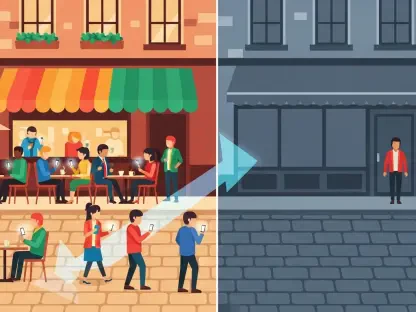In the rapidly shifting landscape of content creation, artificial intelligence (AI) has emerged as a game-changer, offering tools that promise to streamline workflows and enhance productivity for creators across various fields. Among these innovations are AI humanizers, designed to polish machine-generated text into something that feels more natural and engaging to readers. Yet, as these tools gain traction, a critical question looms: can they truly match the finesse and depth of human editing, a craft honed by years of experience and intuition? This exploration seeks to unpack the nuances of both approaches, delving into their strengths, limitations, and practical applications. With content demands growing in volume and complexity, understanding how AI humanizers stack up against human editors is vital for creators aiming to balance efficiency with quality. The journey through this comparison reveals not just a contest of technology versus tradition, but also a potential synergy that could redefine how compelling content is crafted in the digital age.
Understanding the Tools
AI Humanisers: Technology in Action
AI humanizers represent a significant leap in content refinement, leveraging sophisticated algorithms to transform the often rigid and mechanical output of AI-generated text into something more natural. These tools analyze patterns such as sentence structure, tone, and predictability, adjusting elements to mimic the natural flow of human writing. Their adaptability shines across various domains, from academic essays to marketing copy, where they can tailor content to specific styles or audiences with remarkable speed. What makes them particularly appealing is their ability to deliver results almost instantly, often at a fraction of the cost of traditional methods. For content creators handling high-volume tasks, this efficiency is a major draw, allowing quick revisions without the need for extensive manual input. However, while they excel at surface-level improvements, the depth of emotional resonance or unique voice often remains elusive, highlighting a gap that technology struggles to bridge in its current form.
Beyond their technical prowess, AI humanizers are reshaping expectations around content turnaround times and scalability. Their consistent application of rules ensures uniformity, which is especially beneficial for large projects requiring a standardized tone or format. Businesses and freelancers alike find value in this reliability, as it minimizes variability in output, a common challenge with multiple human contributors. Yet, this consistency can sometimes translate into a lack of originality, as the algorithms rely on predefined patterns rather than innovative thinking. The trade-off between speed and creativity becomes evident when content needs to stand out or evoke a specific emotional response. While these tools undoubtedly enhance productivity, they often leave users questioning whether the polished text truly connects with readers on a personal level, pointing to inherent limitations in capturing the full spectrum of human expression.
Human Editing: The Craft of Refinement
Human editing stands as a testament to the irreplaceable value of personal insight and creativity in content development. Unlike automated systems, editors bring a profound understanding of context, cultural nuances, and audience expectations, allowing them to refine text in ways that resonate deeply. Their work goes beyond correcting grammar or syntax; it involves infusing a piece with personality, ensuring the author’s voice shines through while aligning with strategic goals. This bespoke approach is particularly critical for content where emotional impact or persuasive power is paramount, as human editors can adapt messaging to subtle shifts in tone or intent. Though this process demands more time and investment, the resulting quality often justifies the effort, especially in scenarios where connection and authenticity are non-negotiable for success.
The artistry of human editing lies in its ability to navigate complexities that machines cannot grasp, such as ethical considerations or cultural sensitivities, which are often beyond the reach of automated systems. Editors frequently act as storytellers, weaving narratives that engage and inspire by drawing on intuition and lived experience, elements absent in algorithmic processes. This capacity to challenge assumptions or refine ideas ensures content not only meets technical standards but also carries meaningful impact. Additionally, human editors excel in tailoring feedback to the specific needs of a project, offering insights that elevate the material beyond its initial draft. While the slower pace and higher costs associated with this method can pose challenges, the depth and thoughtfulness they provide remain unmatched, making human editing a cornerstone for high-stakes or nuanced content that demands a personal touch.
Key Comparisons
Speed, Cost, and Consistency
When evaluating AI humanizers and human editing, the dimensions of speed and cost often tilt heavily in favor of technology. AI tools can process and refine content in mere seconds, a stark contrast to the hours or days human editors might require for thorough revisions. This rapid turnaround is paired with affordability, as many AI solutions operate on subscription models or one-time fees that are significantly lower than professional editing rates. Consistency further bolsters their appeal, as these tools apply uniform standards across vast amounts of text without the variability that human fatigue or subjectivity might introduce. For projects with tight deadlines or limited budgets, such as bulk social media content or routine updates, AI humanizers offer a practical solution that keeps workflows moving without breaking the bank.
However, this efficiency comes with trade-offs that become apparent when examining the broader picture of content quality. Human editors, though slower and more expensive, provide a level of customization that AI struggles to replicate, tailoring their work to the unique needs of each piece. Their meticulous approach often uncovers issues or opportunities that automated systems overlook, such as subtle tonal shifts or strategic alignments. While AI delivers unwavering consistency, it can also result in outputs that feel formulaic, lacking the dynamic flair humans naturally bring. The investment in human editing, therefore, often pays off in scenarios where differentiation or impact is critical, underscoring that speed and cost are not the sole metrics of value. Balancing these practical considerations against desired outcomes is essential for content creators navigating their options.
Depth and Creativity
On the spectrum of depth and creativity, human editing holds an undeniable edge, rooted in the ability to perceive and convey intricate emotional and cultural layers. Editors draw on a wealth of experience to craft content that not only communicates a message but also stirs feelings or sparks thought, ensuring it resonates with specific audiences. Their knack for weaving in originality—whether through a clever turn of phrase or a nuanced perspective—sets their work apart, particularly in creative writing or branding materials where a distinct voice is paramount. This human capacity to interpret intent and context allows for refinements that elevate content beyond mere clarity, turning it into a powerful tool for connection and influence, an area where technology often falls short.
AI humanizers, despite remarkable advancements, frequently struggle to match the level of creative insight that human editors offer, as their refinements are driven by patterns and data rather than genuine understanding. While they can enhance readability and adjust tone to a degree, the results often lack the soulful spark or unexpected flair that human editors provide. The algorithms may improve the flow of text, but they cannot replicate the intuitive leaps or cultural awareness that shape truly memorable content. This limitation becomes evident in projects requiring a deep personal touch or innovative storytelling, where AI outputs might feel adequate but rarely exceptional. As content creators weigh their options, recognizing this gap in creative depth is crucial, especially when the goal is to leave a lasting impression on readers.
Practical Applications
Choosing the Right Approach
Deciding between AI humanizers and human editing hinges on the specific demands and constraints of a given project, as each method serves distinct purposes. For tasks that prioritize speed and volume—such as drafting social media posts, generating initial blog content, or producing routine reports—AI tools offer an undeniable advantage. Their ability to quickly refine large batches of text at a low cost makes them ideal for creators who need to maintain a consistent output without extensive resources. This practicality shines in fast-paced environments where getting content out promptly often outweighs the need for intricate personalization, allowing teams to meet deadlines and scale efforts with ease. However, the trade-off in depth means these tools are best suited for preliminary or less critical work.
In contrast, human editing becomes indispensable when the stakes are higher, and content must carry significant weight or authenticity, such as in academic publications, business proposals, or narrative-driven pieces. Editors bring a level of scrutiny and personalization that ensures the material aligns with complex goals, resonates emotionally, or adheres to cultural norms. Their ability to refine beyond surface errors, addressing tone, intent, and audience perception, makes them the preferred choice for projects where impact outweighs efficiency. The decision, therefore, requires a clear assessment of priorities—whether time and budget take precedence or if quality and connection are the ultimate goals. Content creators must weigh these factors to select an approach that aligns with their vision and resources.
Sensitive and Strategic Content
When content involves sensitive topics or strategic communication, the nuanced expertise of human editors becomes not just beneficial but often essential to ensure the message is conveyed appropriately. Issues such as ethical messaging, cultural sensitivities, or controversial subjects demand a level of judgment and empathy that AI humanizers cannot provide, given their reliance on pre-programmed logic. Human editors can navigate these complexities, ensuring that the tone remains appropriate and the message avoids unintended offense or misinterpretation. Their ability to anticipate reader reactions and adjust accordingly is critical in maintaining trust and credibility, particularly in fields like public relations or advocacy where every word carries weight. This human oversight acts as a safeguard against potential pitfalls that automated tools might miss.
Moreover, strategic content—such as high-level corporate communications or persuasive campaigns—benefits immensely from an editor’s ability to align messaging with broader objectives. Beyond polishing text, they can challenge underlying assumptions, refine arguments, and ensure the content serves its intended purpose, whether to inspire action or build brand loyalty. AI tools, lacking true comprehension, often fall short in these scenarios, producing outputs that may be grammatically correct but strategically hollow. The depth of insight human editors offer ensures that critical content not only meets technical standards but also achieves its ultimate goals. For creators handling delicate or high-impact material, this level of care is a necessary investment, highlighting why human intervention remains unmatched in certain contexts.
The Future of Content Creation
Embracing a Hybrid Model
A growing trend in content creation points toward a hybrid model that combines the strengths of AI humanizers and human editing, offering a balanced solution to modern challenges. In this approach, AI tools take on the initial heavy lifting, refining raw drafts or large volumes of text with speed and consistency, thus saving valuable time and resources. This allows content creators to focus on ideation rather than repetitive tasks, streamlining the early stages of production. Once the groundwork is laid, human editors step in to elevate the material, adding layers of creativity, emotional depth, and cultural relevance that algorithms cannot replicate. This collaboration ensures efficiency without compromising the personal touch that often defines impactful content, presenting a workflow that adapts to diverse needs.
The hybrid model also offers flexibility, catering to varying project scopes and budgets by allocating tasks based on their complexity. For instance, routine or low-stakes content can remain largely AI-driven with minimal human oversight, keeping costs down while maintaining acceptable quality. Conversely, pieces requiring a distinct voice or strategic finesse benefit from extended human input after AI lays the foundation. This synergy not only maximizes productivity but also fosters innovation, as creators can experiment with AI outputs before refining them with human insight. As technology continues to evolve, this integrated approach is poised to become a standard, providing a framework that leverages the best of both worlds while addressing the limitations of each method on its own.
Balancing Technology and Expertise
The integration of AI into content creation reflects a broader shift toward balancing technological efficiency with human expertise, a dynamic that is reshaping creative industries. AI humanizers excel at handling repetitive or data-intensive tasks, enabling scalability that was previously unattainable for many creators. Their role as a supportive tool frees up human editors to focus on higher-order challenges, such as crafting narratives or ensuring ethical messaging, rather than getting bogged down in minutiae. This division of labor enhances overall output, allowing teams to produce more content without sacrificing the quality that human insight guarantees. The trend underscores a recognition that technology serves best as an enabler, not a replacement, for the nuanced skills editors bring to the table.
Achieving this balance, however, requires a strategic mindset to ensure neither element overshadows the other, preserving the unique contributions of both. Content creators must remain vigilant about over-relying on AI, as excessive dependence risks diluting the authenticity or emotional resonance that audiences often seek. At the same time, embracing technology’s potential can alleviate workload pressures, providing space for human editors to innovate and connect on deeper levels. This equilibrium is becoming a critical skill in an era where content demands are both voluminous and varied. By fostering collaboration between AI and human efforts, the industry can meet current needs while paving the way for future advancements, ensuring that creativity and efficiency coexist harmoniously.
Broader Implications
Evolving Workflows in Creative Industries
The advent of AI humanizers signals a transformative shift in creative workflows, prompting professionals across industries to rethink traditional approaches to content production. As technology automates routine tasks like grammar checks or stylistic adjustments, it allows creators to redirect their focus toward strategic and innovative aspects of their craft. This evolution, however, raises important questions about the long-term role of human editors in an increasingly tech-driven landscape. While AI boosts productivity, the consensus leans toward a collaborative future where technology handles foundational work, and humans drive the vision and emotional impact. Such a shift necessitates adaptability, as skills once central to editing may need to evolve to complement automated tools, ensuring relevance in a changing field.
This transformation also highlights the importance of continuous learning for content professionals, as staying abreast of technological advancements becomes essential to maintaining a competitive edge. The integration of AI into daily workflows is not merely a trend but a fundamental change, influencing everything from project timelines to team structures. While the efficiency gains are undeniable, there remains a need to safeguard the human elements that define compelling content, such as empathy and originality. As industries adapt, the focus shifts to creating systems where technology and expertise reinforce each other, fostering an environment where innovation thrives without losing the essence of personal connection that has long defined creative work.
Meeting Diverse Content Needs
Content creation today spans a vast spectrum, from fleeting social media updates to meticulously crafted corporate documents, each with unique demands that no single approach can universally address. AI humanizers prove invaluable for quick, high-volume outputs where immediacy and consistency are key, ensuring that basic quality standards are met with minimal effort. Conversely, human editing remains the gold standard for materials requiring depth, authenticity, or strategic intent, as it delivers a tailored impact that resonates with specific audiences. Recognizing the distinct value each method offers empowers creators to make informed choices, aligning their approach with the content’s purpose and the resources at hand, thereby optimizing both efficiency and effectiveness.
Beyond individual projects, this diversity in content needs reflects the broader challenge of maintaining relevance in a dynamic digital landscape where audience expectations constantly evolve. A blended strategy, incorporating both AI and human input as circumstances dictate, provides the flexibility to navigate these shifts without compromising on quality or speed. For instance, hybrid workflows can scale to handle sudden spikes in demand while still delivering polished, impactful pieces when required. This adaptability ensures that creators can meet varied demands—whether casual or critical—while staying attuned to emerging trends. Ultimately, the ability to strategically deploy AI humanizers and human editing equips professionals to craft content that not only meets but exceeds modern standards, securing engagement in an ever-competitive space.









